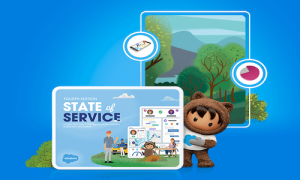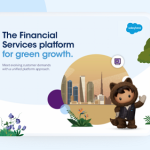For service organisations, choosing the right KPIs can help teams get to the heart of what really matters: the customer. But as lockdown measures caused more people to shop online, expectations for customer service shifted and the bar for customer satisfaction raised. The wave of new digital adopters quickly became accustomed to rapid service, 24/7 engagement, and seamless customer experiences.
The State of the Connected Customer Report shows that 83% of customers expect to immediately interact with someone when they contact a company. Moreover, 82% expect to solve complex problems by talking to one person.
Some service organisations tackled these new expectations by scaling up their digital investments or turning to reskilling and upskilling programs to build a more agile workforce. Others found themselves stuck in neutral, still trying to create a roadmap for a successful digital transformation.
Measuring the state of service and how it impacts service organisations
To find out what challenges today’s global service leaders are facing — and how they’re adapting to overcome them — Salesforce surveyed over 7,000 customer service professionals from around the world. The results are compiled in the 4th Edition of the State of Service Report.
Let’s dig into the report and see what key performance indicators (KPIs) service organisations are using to measure success in a changing world.
Traditional KPIs for service organisations are changing
For many service organisations, KPIs like ‘average resolution time’ and ‘employee productivity’ have long been considered top priorities. And make no mistake; speed and productivity are both important KPIs. But in a time of customer-centricity, when reps are being looked at as brand ambassadors and advisors, new KPIs are taking centre stage.
New priorities after the global pandemic:
-
Soft skills like listening and empathy have grown more important as customers struggle with the ongoing effects of multiple crises.
-
Reps who have shifted to remote working are learning new skills in a new climate.
-
Leaders are focusing more and more on teamwork, collaboration, and long-term outcomes.
-
Flexibility is prioritised and meaningful engagement is more important than ever.
Essentially, things like NPS (Net Promoter Score) are becoming less important than focusing on long-term relationships and customer retention.
The most important KPIs for service organisations
According to our report, 71% of service professionals say that the pandemic has led to them changing or reprioritising their KPIs. There’s been an especially notable increase in teams that track revenue, case deflection, and customer retention.
What’s even more notable is the rise in the number of service organisations using metrics, as every KPI is being tracked more now than it was just two years ago. It’s clear that we’re in the midst of a data-driven era, and service teams are using more KPIs to optimise their service; especially in high-performing service organisations.
Top 5 service KPIs, as revealed by the State of Service:
1. Customer satisfaction (+7% vs 2018)
It’s no surprise that customer satisfaction is the most tracked metric for service organisations. More notably, however, is the gap between the number of high-performing sales teams that track customer satisfaction as a KPI and the number of underperforming ones that do.
While 93% of high-performers track customer satisfaction, only 69% of underperforming organisations say they do the same. This corresponds with general attitudes towards the importance of being proactive with data, with 78% of high-performing teams saying that they’ve changed their KPIs as a result of the pandemic, compared to just 58% of underperformers. In fact, high-performing organisations are measuring more KPIs across the board.
2. Revenue (+29% from 2018)
The percentage of organisations that track revenue has grown by 29% since 2018, making it the fastest-growing KPI. But why is tracking revenue so much more important for today’s service teams than it was just two years ago?
For starters, economic conditions have limited many businesses, leading to stagnant or declining budgets. Organisations are also struggling with reduced resources and not being able to keep up with customer demands. Tracking service’s impact on profits can help businesses better manage their resources in tough times.
3. Customer retention (+22% from 2018)
It can cost upwards of 5x as much for businesses to attract a new customer than retain an old one, so building long-term relationships makes fiscal sense. But customer retention also helps service teams build brand advocates.
This is becoming increasingly important in the New Normal, where the competition is just a click away. So it’s no surprise that the amount of service organisations that have made customer retention a key performance indicator has risen by 22%.
4. Customer effort (+16% from 2018)
Measuring customer effort is becoming more important in the current climate, as providing outstanding experiences has become the norm. Service organisations may be hitting benchmarks when analysing SLA performance (see KPI 5). But it’s worth noting whether those SLA benchmarks are keeping pace with increasing customer expectations.
Perhaps a better way to view performance from the customer’s POV is to measure how well a service organisation is doing at lowering ‘customer effort’. Or the burden organisations place on customers before, after, and during interactions. According to Gartner, customer effort has a huge effect on loyalty, and delivering low-effort experiences can help improve everything from Net Promoter Scores to employee retention rates.
5. SLA performance (+16% from 2018)
Measuring SLA (Service Level Agreements) performance provides a good baseline for service organisations. It’s essential for them to see if they’re meeting the standards and expectations of their company.
SLA performance analyses the quality of service provided to both stakeholders and externals clients, taking into account a variety of different metrics. It’s important that the benchmarks are viewed in context of the new reality. Considering, pre-COVID-19 SLA were drawn up in a different world with far fewer demands on reps.
Improve customer satisfaction with Salesforce
It’s a challenging world for service organisations, no matter how they choose to measure it. But choosing the right KPIs can help teams get to the heart of what really matters – the customer. In an age where customer satisfaction is non-negotiable, Salesforce solutions like Einstein, Service Cloud, and Field Service software can empower reps to deliver outstanding service – on time, every time.
To see more about how today’s service teams are measuring success, download the State of Service, 4th Edition today.
























